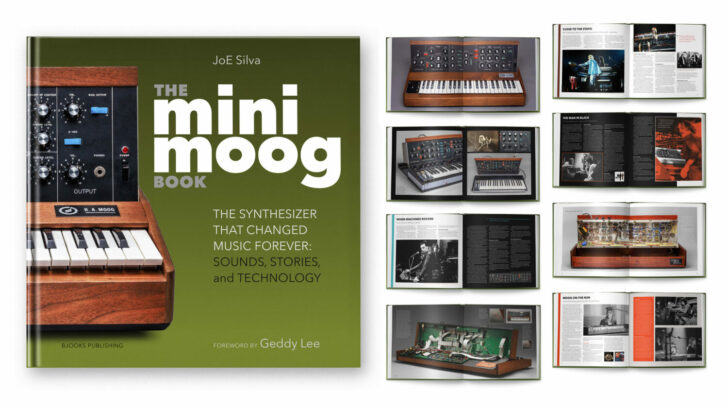Kim Bjørn, founder of Danish independent book publisher Bjooks, has officially announced their latest synth book, The Minimoog Book.
The comprehensive book – by author, journalist, and music historian Joe Silva– chronicles the Minimoog’s history, from its earliest prototypes and the very first Model D #1001, through the Minimoog Voyager models and into the present day.
Production of the book is being funded via a Kickstarter project, which will launch later this month.
“When I started digging into the history of the Minimoog back in 2010,” Silva noted, “I quickly realized how universal it was. I was continuously stumbling upon artist after artist or another famous piece of music that used it. It was pretty clear right away how important the instrument became once it came out…”
The book features a foreword from Rush frontman Geddy Lee, along with interviews and features with musicians like Keith Emerson, Rick Wakeman, Chick Corea, Tony Visconti (David Bowie), George Duke, Anne Dudley (Art of Noise), Bernie Worrell, Devo, Kraftwerk, Air, J Dilla, Gary Numan, and others.
The book also features detailed photography, schematics, historical promotional materials, engineering interviews, illustrated sound patches, and over 70 artist features.
Pricing and Availability:
The Minimoog Book will be available for pre-order on Kickstarter later in April. Early supporters will get access to special perks and insider info like never-before-seen photos, behind-the-scenes content, a special edition of the book, and more.
For more information and to be notified when the book is officially available, visit the Bjooks website.


The Minimoog is arguably the greatest mass produced synth of all time, but its sounds have been done to death for over half a century.
You say that like it’s a bad thing.
Some people are into synths for novelty, others are into synths as instruments for what they can do.
The piano is arguably the greatest mass produced instrument of all time, but its sounds have been done to death for over three hundred years.
The piano is capable of playing chords and polyphonic playing and expressiveness (hence the translated name pianoforte, soft-loud), which opens up a wide musical world.
The Minimoog has been done to death; that’s obviously an opinion. There are so many synths that I prefer to hear (after decades of same ole same ole from the Minimoog).
EXACTLY what I was thinking!
80% of people program the same same fundamental bass sounds on the Minimoog and leave it set to that with minor variations. Minor adjustments to cutoff or resonance perhaps, and the oscillators are almost always in unison.
I’ve not owned a Minimoog, but, I’ve played with a few. There are a lot of innovative sounds you can make on it, particularly when you start tuning the oscillators at different intervals.
Not everyone with Les Paul and a Marshall JCM are going to sound the same.
maybe 80% of the people you know, most people i know use the knobs.
You obviously listen to very boring music then
That you can identify the Minimoog every time
In my opinion : the Model D is not the most modern analog synth….BUT for live work it is easily to use and tweaking. Just like an original acoustic instrument. It have a wonderful look also !
Model D is not Minimoog. However, it is only moog I can afford.
This probably won’t get posted as synthtopia seems to have a block on me, which is interesting as there are at least a thousand other people that work here, and at least half of the posts here are vile opinionated insults, but here goes: the Minimoog revolutionized music and put balls on every keyboardist in the 70s who had to compete with a guitarist for solo time and space in an arrangement. Bill Hemsath, standing on the shoulders of Dr. Bob Moog, effectively invented an entirely new musical instrument. I’d love to read this book before I invested in it, in order to make sure the author got the story correct…
I don’t think being pretentious is moderated so you should be fine.
I salute you sir.
The Minimoog was my springboard. Its a warm form of history to me now, since its so easy to emulate it, but it taught me plenty. One solid lesson: its too dry in its bare state, but just a dash of chorus & delay or reverb makes the voice blossom.
Its easy to acquire solid Moog voices now. For me, it was Cherry Audio’s Memorymode. With a sprinkle of effects, I can get a Unison voice to bark like the hardware did, but it all started with a Mini.
no brainer i guess. personally it’s less the about instrument than the music done with it for me.
maybe a MadLib’s version would be cool for kids.